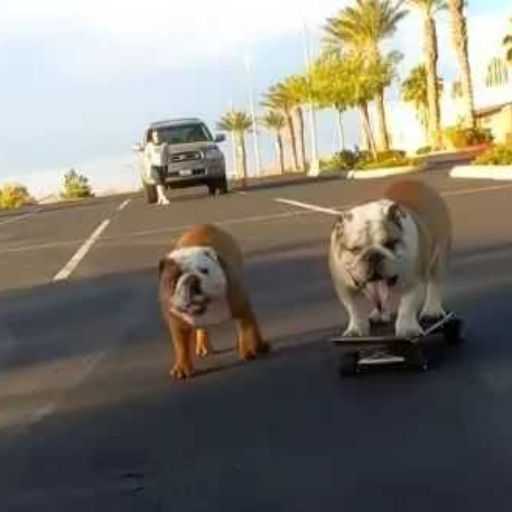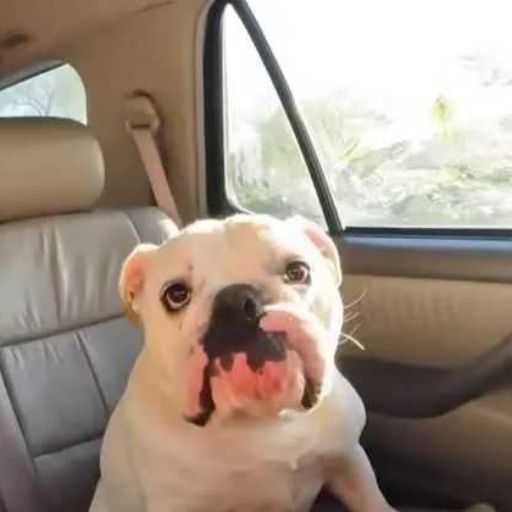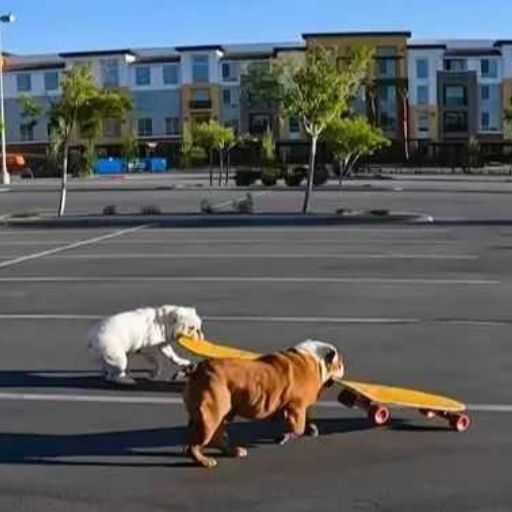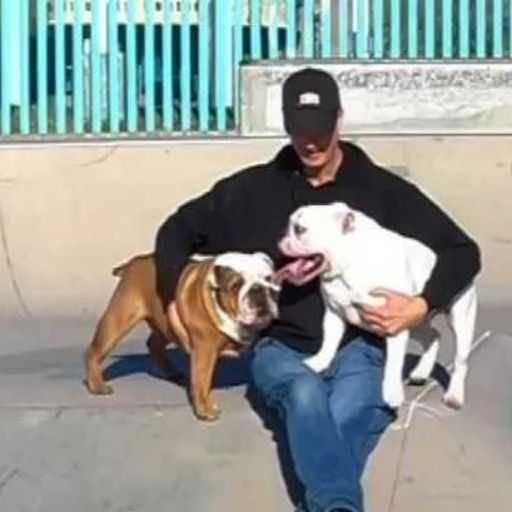The crisp morning air nipped at their noses as Ben pushed open the car door. Walter, the younger English bulldog, scrambled out, his stubby legs churning as he made a beeline for the familiar sight – the skate park. Forget the leash and the stroll around the block; this was Walter’s kind of walk. Here, amidst the metal ramps and smooth concrete, Walter wasn’t just a dog – he was a skater.

Ben chuckled, his heart swelling with the joy that only his furry companions could bring. It all started with George, Walter’s older brother. A stockier, more determined bulldog, George had possessed an uncanny knack for balancing on a skateboard. Ben, a lifelong skateboarder himself, couldn’t resist the challenge. He’d spend hours patiently guiding George, the click of his tongue a cue to push off, a gentle lift a nudge in the right direction.

It wasn’t easy. George’s short legs and stocky build weren’t exactly built for athletic prowess. Yet, his determination was infectious. Slowly, he began to master the art of pushing off, balancing for short bursts, and even navigating gentle slopes. Every successful ride was met with an excited bark and a triumphant wag of his short, curly tail.

The park became their haven. Early mornings, before the sun climbed high and the crowds gathered, were their time. Ben would navigate the ramps alongside his canine companion, a grin plastered across his face as George, tongue lolling out in concentration, proudly glided on his four-wheeled chariot. As George grew more confident, Walter, always his shadow, watched with an intensity that bordered on jealousy. Then, one day, something clicked. Perhaps it was the endless hours of observing, or maybe the sheer joy emanating from George, but Walter decided it was his turn.

Ben, ever the patient trainer, started him slowly. A smaller board, a gentle nudge – Walter surprised everyone with his natural aptitude. He wasn’t as fast as George, but his balance was phenomenal. He loved cruising along the flat ground, his bulldog head held high, a picture of pure, unadulterated joy.

Then, tragedy struck. George, the pioneer, the inspiration, passed away. The park felt empty without his enthusiastic barks and unwavering determination. Walter, for a while, lost his spark. But the park, their sanctuary, remained. Ben, heartbroken yet determined to honour his furry friend, decided to open their lives to another bulldog. Enter Milo, a bundle of wrinkles and boundless energy.

Milo, unlike Walter, wasn’t content with simply cruising. He had a different kind of ambition. He’d watch Walter with rapt attention, then try to mimic his pushes with his powerful jaws. Ben, initially hesitant, eventually found a way to secure the board, allowing Milo to push with his mouth. It was a sight to behold – a bulldog, tongue lolling out in concentration, propelling himself forward on a skateboard.

And then, came the moment that left Ben speechless. Milo, after months of practice, managed to balance on the board for a few precious seconds. The pure unadulterated joy in his eyes mirrored the one that shone in Ben’s. George might be gone, but his legacy lived on. He had paved the way, not just for Walter, but for Milo as well.

Snowboarding became their winter adventure. With Ben carefully crafting a custom harness, they took to the slopes, the bulldogs surprisingly adept at navigating the white powder. Their short legs proved to be an advantage, allowing them to maintain a low centre of gravity, their powerful bodies propelling them forward.

Life for Ben revolved around his furry companions. Their schedules dictated his day. Early mornings for the park, afternoons for walks and playtime, evenings for snuggles on the couch. Through it all, there was the constant companionship, the unconditional love, and the shared joy of conquering new challenges on a skateboard.

Some may have questioned Ben’s unconventional methods, the sight of bulldogs on skateboards raising a few eyebrows. But Ben didn’t care. He saw the immense joy it brought his dogs, the confidence that bloomed in their eyes, the unique bond that transcended the boundaries of species. In their special way, George, Walter, and Milo were rewriting the narrative of what bulldogs could achieve. They were skateboarders, defying expectations, one wobbly push at a time.

Watch The Full Video Here:
If you’ve ever wondered about adding a citrusy twist to your furry friend’s diet, the topic of oranges for dogs might pique your interest. As a seasoned dog trainer, you’re always on the lookout for new ways to keep your canine companion healthy and happy. Oranges, with their vibrant color and tangy flavor, seem like they could be a refreshing addition to your dog’s treat repertoire.
You’re familiar with the importance of a balanced diet for your four-legged friend, but when it comes to fruits like oranges, you might have some questions. Can dogs enjoy the same juicy goodness that we do, or are there hidden risks lurking beneath the peel? Before you decide to share your snack with your pup, it’s essential to understand the potential benefits and considerations when it comes to feeding oranges to your furry pal.
Nutritional Benefits of Oranges for Dogs
Oranges are known for being a good source of vitamin C, and the same applies to your furry friend. They are packed with essential nutrients that can benefit your dog’s overall health.
1. Vitamin C Boost:
Oranges are rich in vitamin C, which plays a crucial role in supporting your dog’s immune system. It helps in fighting off infections and maintaining a healthy immune response.
2. Antioxidant Power:
The antioxidants present in oranges can help neutralize harmful free radicals in your dog’s body, potentially reducing the risk of chronic diseases.
3. Hydration Support:
Oranges have a high water content, making them a hydrating snack for your dog. Proper hydration is essential for your dog’s overall well-being.
4. Fiber Intake:
Feeding your dog oranges in moderation can contribute to their fiber intake. Fiber aids in digestion and can help regulate bowel movements.
5. Low in Calories:
Oranges are a low-calorie treat option for your dog, making them a healthier alternative to some commercial dog treats.
6. Dental Health:
Chewing on orange slices can help promote dental health in dogs by reducing plaque buildup and freshening their breath.
Risks of Feeding Oranges to Dogs
When it comes to feeding your canine friend oranges, be cautious about potential risks. Here are some important points to consider:
- Digestive Upset: Oranges can be difficult for some dogs to digest, leading to diarrhea or stomach discomfort. Introduce oranges gradually and monitor your dog’s response.
- Sugar Content: Oranges contain natural sugars that may not sit well with all dogs, especially those with certain health conditions like diabetes. Too much sugar can cause a spike in blood glucose levels.
- Acidic Nature: The acidity of oranges might not agree with every dog’s stomach, potentially causing issues like acid reflux or upset stomach. Keep an eye out for any signs of sensitivity.
- Allergies: Some dogs may have allergies to citrus fruits like oranges. Watch for symptoms such as itchiness, hives, or swelling after consumption. If you notice any allergic reactions, refrain from feeding oranges.
- Choking Hazard: The tough peel of an orange can pose a choking hazard to dogs, especially small breeds. Remove all seeds and tough membranes before offering any orange slices to your furry companion.
- Caloric Intake: Despite being low in calories, too many oranges can contribute to excessive caloric intake for your dog. Moderation is key to prevent weight gain and other health issues.
By being aware of these risks and monitoring your dog’s response, you can make an informed decision about whether oranges are suitable for your pet. Always consult your veterinarian if you have concerns about adding new foods to your dog’s diet.
How to Safely Feed Oranges to Dogs
When it comes to giving oranges to your furry friend, there are a few essential steps to follow to ensure their safety and enjoyment:
- Peeling and Preparing: Always remove the peel and any seeds before offering oranges to your dog. The tough outer skin can be difficult for them to digest, and seeds may pose a choking hazard.
- Moderation is Key: Oranges should be given to your dog in moderation. While vitamin C is beneficial, too much citrus can upset your dog’s stomach due to its acidity and high sugar content.
- Watch for Allergic Reactions: Just like humans, dogs can have allergies too. Introduce oranges slowly into your dog’s diet and watch for any signs of allergic reactions such as itching, swelling, or gastrointestinal upset.
- Consult Your Veterinarian: Before introducing oranges or any new food to your dog’s diet, it’s always a good idea to consult your veterinarian. They can provide guidance tailored to your pet’s specific needs.
Remember, dogs have different dietary requirements than humans, so it’s essential to be mindful of how oranges may affect your pet. By following these steps, you can safely treat your dog to the occasional orange as a tasty and nutritious snack.
Signs of Orange Allergy in Dogs
If your furry friend shows any of the following signs after consuming oranges, they might have an orange allergy:
- Digestive Disturbances
If your dog experiences vomiting, diarrhea, or constipation after eating oranges, it could indicate an allergic reaction. - Skin Irritations
Watch out for signs of skin redness, itchiness, hives, or swelling. These could be indications of an allergic response to oranges. - Excessive Scratching
Constant scratching, especially around the face, ears, or body, may suggest an allergic reaction from ingesting oranges. - Respiratory Issues
Difficulty breathing, coughing, wheezing, or sneezing excessively post-orange consumption can be signs of an orange allergy in dogs. - Behavioral Changes
Unusual behaviors like restlessness, lethargy, or excessive drooling after eating oranges may also point towards an orange allergy.
Always monitor your dog closely when introducing new foods like oranges into their diet. If you observe any of these signs, consult your veterinarian promptly to ensure your pet’s health and well-being.
Conclusion
So, there you have it! Oranges can be a tasty and nutritious treat for your furry friend, but it’s important to be mindful of potential risks. Keep an eye out for any signs of orange allergy in your dog and introduce this citrus fruit gradually. Remember, your pup’s health always comes first, so if you notice any unusual reactions, don’t hesitate to reach out to your vet. By understanding the benefits and risks of feeding oranges to your dog, you can make informed decisions to ensure their well-being. Happy snacking with your canine companion!
Frequently Asked Questions
Can I feed oranges to my dog?
Yes, you can feed oranges to your dog in moderation. Oranges are a good source of vitamin C and fiber, but be cautious of overfeeding due to their high sugar content.
What are the risks of feeding oranges to dogs?
The main risks of feeding oranges to dogs include digestive upset, choking hazards from the seeds, and potential allergic reactions. Monitor your dog for any adverse effects.
How do I know if my dog is allergic to oranges?
Signs of orange allergy in dogs can include digestive disturbances, skin irritations, excessive scratching, respiratory issues, and behavioral changes. Consult a vet if you notice any unusual symptoms.
What should I do if my dog has an allergic reaction to oranges?
If your dog shows signs of an allergic reaction to oranges, stop feeding them immediately and seek advice from a veterinarian to address any health concerns promptly.

Hey there, I’m Janet Brooks, a dog-loving student from California. I’m all about helping pups in need, especially those without homes. Me and my awesome friends work together to give shelter and love to stray dogs. Oh, and I also write blogs about dogs to share helpful info.